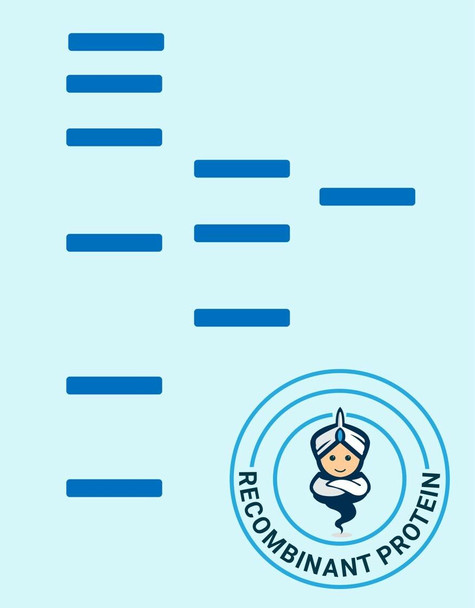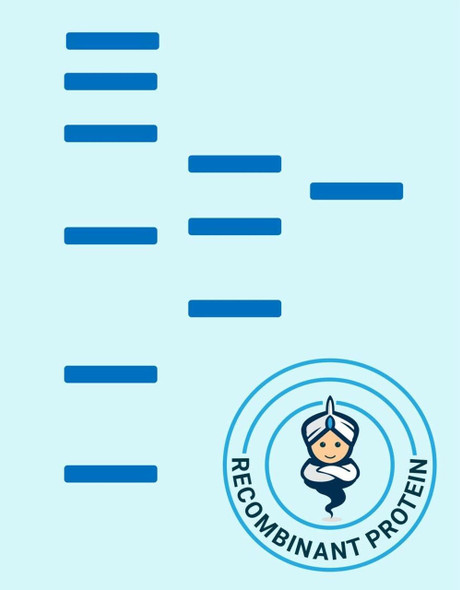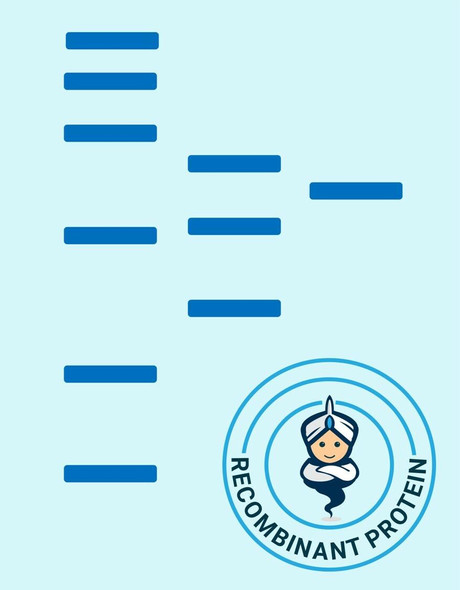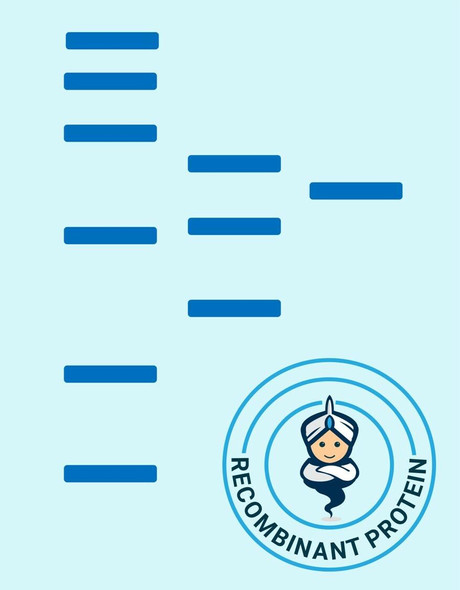Description
| Product Name: | Human CRYBA4 Recombinant Protein |
| Product Code: | RPPB5196 |
| Size: | 20µg |
| Species: | Human |
| Target: | CRYBA4 |
| Synonyms: | Beta-crystallin A4, Beta-A4 crystallin, CRYBA4, MCOPCT4. |
| Source: | Escherichia Coli |
| Physical Appearance: | Sterile filtered colorless solution. |
| Formulation: | The CRYBA4 protein (1mg/ml) 20mM Tris-HCl buffer (pH8.0), 20% glycerol, 0.1M NaCl and 1mM DTT. |
| Stability: | Store at 4°C if entire vial will be used within 2-4 weeks. Store, frozen at -20°C for longer periods of time. For long term storage it is recommended to add a carrier protein (0.1% HSA or BSA).Avoid multiple freeze-thaw cycles. |
| Purity: | Greater than 95.0% as determined by SDS-PAGE. |
| Amino Acid Sequence: | MGSSHHHHHH SSGLVPRGSH�MTLQCTKSAG PWKMVVWDED GFQGRRHEFT AECPSVLELG FETVRSLKVL SGAWVGFEHA GFQGQQYILE RGEYPSWDAW GGNTAYPAER LTSFRPAACA NHRDSRLTIF EQENFLGKKG ELSDDYPSLQ AMGWEGNEVG SFHVHSGAWV CSQFPGYRGF QYVLECDHHS GDYKHFREWG SHAPTFQVQS IRRIQQ |
Beta-crystallin A4 (CRYBA4) is a member of the beta/gamma-crystallin family which are the dominant structural components of the vertebrate eye lens. Beta-crystallins construct aggregates of various sizes and are able to self-associate to form dimers or to form heterodimers with other beta-crystallins. The CRYBA4 gene being a beta acidic group member is part of a gene cluster with beta-B1, beta-B2, and beta-B3.
CRYBA4 Human Recombinant produced in E.Coli is a single, non-glycosylated polypeptide chain containing 216 amino acids (1-196 a.a.) and having a molecular mass of 24.5kDa.CRYBA4 is fused to a 20 amino acid His-tag at N-terminus & purified by proprietary chromatographic techniques.
| UniProt Protein Function: | CRYBA4: a major structural protein of the eye lens. A member of the beta/gamma-crystallin family. |
| UniProt Protein Details: | Chromosomal Location of Human Ortholog: 22q12.1 Molecular Function:protein binding Biological Process: camera-type eye development; visual perception Disease: Cataract 23 |
| NCBI Summary: | Crystallins are separated into two classes: taxon-specific, or enzyme, and ubiquitous. The latter class constitutes the major proteins of vertebrate eye lens and maintains the transparency and refractive index of the lens. Since lens central fiber cells lose their nuclei during development, these crystallins are made and then retained throughout life, making them extremely stable proteins. Mammalian lens crystallins are divided into alpha, beta, and gamma families; beta and gamma crystallins are also considered as a superfamily. Alpha and beta families are further divided into acidic and basic groups. Seven protein regions exist in crystallins: four homologous motifs, a connecting peptide, and N- and C-terminal extensions. Beta-crystallins, the most heterogeneous, differ by the presence of the C-terminal extension (present in the basic group, none in the acidic group). Beta-crystallins form aggregates of different sizes and are able to self-associate to form dimers or to form heterodimers with other beta-crystallins. This gene, a beta acidic group member, is part of a gene cluster with beta-B1, beta-B2, and beta-B3. [provided by RefSeq, Jul 2008] |
| UniProt Code: | P53673 |
| NCBI GenInfo Identifier: | 2506318 |
| NCBI Gene ID: | 1413 |
| NCBI Accession: | P53673.3 |
| UniProt Secondary Accession: | P53673,Q4VB22, Q6ICE4, |
| UniProt Related Accession: | P53673 |
| Molecular Weight: | 22,374 Da |
| NCBI Full Name: | Beta-crystallin A4 |
| NCBI Synonym Full Names: | crystallin beta A4 |
| NCBI Official Symbol: | CRYBA4�� |
| NCBI Official Synonym Symbols: | CYRBA4; CTRCT23; MCOPCT4�� |
| NCBI Protein Information: | beta-crystallin A4 |
| UniProt Protein Name: | Beta-crystallin A4 |
| UniProt Synonym Protein Names: | Beta-A4 crystallin |
| Protein Family: | Beta-crystallin |
| UniProt Gene Name: | CRYBA4�� |
| UniProt Entry Name: | CRBA4_HUMAN |










